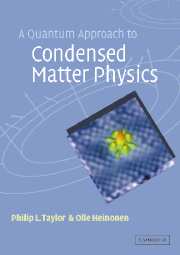Book contents
- Frontmatter
- Contents
- Preface
- Chapter 1 Semiclassical introduction
- Chapter 2 Second quantization and the electron gas
- Chapter 3 Boson systems
- Chapter 4 One-electron theory
- Chapter 5 Density functional theory
- Chapter 6 Electron–phonon interactions
- Chapter 7 Superconductivity
- Chapter 8 Semiclassical theory of conductivity in metals
- Chapter 9 Mesoscopic physics
- Chapter 10 The quantum Hall effect
- Chapter 11 The Kondo effect and heavy fermions
- Bibliography
- Index
Chapter 8 - Semiclassical theory of conductivity in metals
Published online by Cambridge University Press: 05 June 2012
- Frontmatter
- Contents
- Preface
- Chapter 1 Semiclassical introduction
- Chapter 2 Second quantization and the electron gas
- Chapter 3 Boson systems
- Chapter 4 One-electron theory
- Chapter 5 Density functional theory
- Chapter 6 Electron–phonon interactions
- Chapter 7 Superconductivity
- Chapter 8 Semiclassical theory of conductivity in metals
- Chapter 9 Mesoscopic physics
- Chapter 10 The quantum Hall effect
- Chapter 11 The Kondo effect and heavy fermions
- Bibliography
- Index
Summary
The Boltzmann equation
We now have at our command many of the ingredients of the theory of the conduction of heat and electricity. In Section 3.9 we considered the heat current operator for phonons in a lattice, and in Section 4.6 we calculated the velocity of Bloch electrons and their dynamics in applied fields. The missing ingredients of the theory of the transport of heat or electricity, however, are the statistical concepts necessary to understand such irreversible processes. In this chapter we shall adopt the simplest attitude to these statistical problems, and begin with a discussion of the probable occupation number of a given phonon mode or Bloch state.
Let us start by considering a system of independent phonons or electrons. We know that we can define operators nq and nk whose eigenvalues are integers. If, for instance, there are three phonons of wavenumber q′ present then the expectation value 〈nq′〉 of the operator nq′ will be equal to three. If the crystal is not in an eigenstate of the Hamiltonian, however, then 〈nq′〉 may take on some nonintegral value. If we wish to discuss the thermal conductivity of the lattice we should have to interpret the idea of a temperature gradient, and this must certainly involve some departure from the eigenstates of the lattice. We are thus obliged to consider linear combinations of different eigenstates as describing, for example, a lattice with a temperature gradient. Because there will be many different combinations of eigenstates that all give the appearance of a crystal with a temperature gradient we shall only have a very incomplete knowledge of the state of any particular crystal.
- Type
- Chapter
- Information
- A Quantum Approach to Condensed Matter Physics , pp. 285 - 314Publisher: Cambridge University PressPrint publication year: 2002



